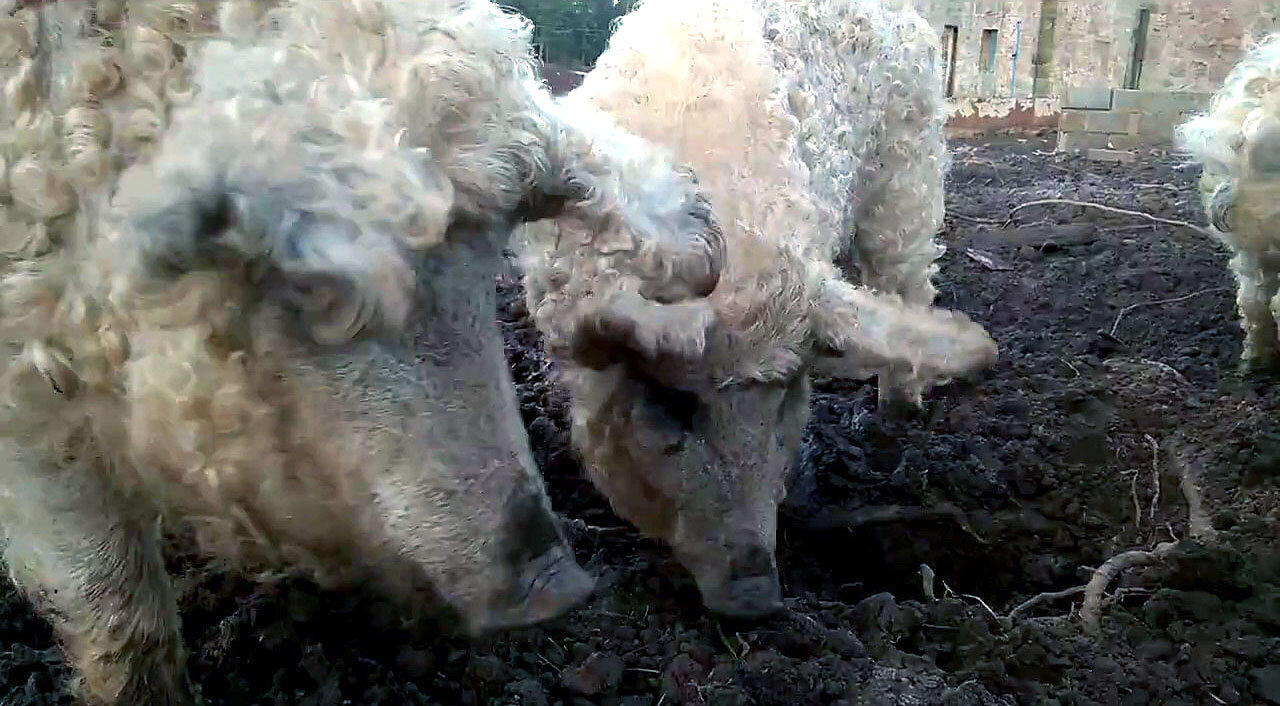Premium Only Content

Meet the Mangalitsa Pig - The Pig looks like a Sheep
The Mangalica (also Mangalitsa or Mangalitza) is a Hungarian breed of domestic pig. It was developed in the mid-19th century by crossbreeding Hungarian breeds from Szalonta and Bakony with European wild boar and the Serbian Šumadija breed. The Mangalica pig grows a thick, woolly coat similar to that of a sheep. The only other pig breed noted for having a long coat is the extinct Lincolnshire Curly-coated pig of England.
The blonde Mangalica was developed from older, hardy types of Hungarian pig (Bakonyi and Szalontai) crossed with the European wild boar and a Serbian breed (and later others like Alföldi) in Austro-Hungary (1833). That year, Prince of Serbia Miloš Obrenović sent 12 pigs of the autochthonous Serbian Šumadinka breed (10 sows and two boars) to the Archduke Joseph, Palatine of Hungary for the new breed to be created. Pigs, originally grown at the Prince's Topčider farm near Belgrade, were used to create the Syrmian black lasa breed, or the black mangalica. The development took place in Austro-Hungary (present-day Arad County in Romania) in the early 19th century. The new, quick-growing, "fat-type" hog did not require any special care, so became very popular in Hungary. In 1927, the National Society of Fat-Type Hog Breeders (Mangalicatenyésztők Országos Egyesülete) was established, with the objective of improving the breed.Mangalica was the most prominent swine breed in the region until 1950 (30,000 of them were in Hungary in 1943). Since then, the popularity, as well as the population, of Mangalica has been decreasing, with the rising availability of food from farther away and refrigeration. In 1991 there were less than 200 animals in Hungary. Monte Nevado, a Spanish company began the breeding and recovery of Mangalica, so they were awarded with the Middle Cross of Hungary in 2016. Nowadays, the keeping of Mangalicas has become a popular hobby. Slightly over 7,000 Mangalica sows in Hungary are producing around 60,000 piglets a year.
Apart from Hungary, the Mangalica is present in Austria, the Czech Republic, Germany, Romania, Serbia, Slovakia, and Switzerland.In Serbia, the breed (called mangulica in Serbian) almost died out by the 1980s. In 1998, Mangalica was introduced in Zasavica. They are left to roam free in the reservation, becoming partially feral and cases of breeding with wild boars are known. By the early 2010s, their number grew to 1,000 in Zasavica plus populations kept in the individual farms in the Syrmia and Mačva regions. As both autochthonous Serbian breeds of domesticated pig, Šiška and Mangalica's predecessor Šumadinka, died out, though developed in Hungary, Mangalica is in Serbia considered as the only surviving autochthonous breed.In March 2006, seventeen of the pigs were exported from Austria to the United Kingdom, where they are registered with the British Pig Association.In 2007 some were exported to the United States.
-
 0:44
0:44
Animal and Insects lives
4 years agoThis Monkey looks like a Vampire
392 -
 25:24
25:24
Scary Mysteries
5 hours agoSTRANGE & SCARY Mysteries of The Month - July 2025
179 -
 LIVE
LIVE
Dr Disrespect
2 hours ago🔴LIVE - DR DISRESPECT - WARZONE - RAGE ON THE MAIN STAGE
2,005 watching -
 1:02:02
1:02:02
Timcast
2 hours agoTrump BULLIES Europe Into MONSTER Trade Deal, Europe COPING Over Trump MASTERCLASS
106K45 -
 2:07:13
2:07:13
Steven Crowder
4 hours ago🔴Game Over: Trump's EU Trade Victory Shows How Stupid "Experts" Really Are
309K149 -
 20:03
20:03
Neil McCoy-Ward
1 hour agoTHE UK 🇬🇧 JUST ENDED 140 YEARS OF FREE SPEECH! (How Did It Come To THIS?!)
3.87K1 -
 1:56:26
1:56:26
The Charlie Kirk Show
2 hours agoTHE CHARLIE KIRK SHOW IS LIVE 07.28.25
35K8 -
 LIVE
LIVE
JuicyJohns
5 hours ago🟢#1 REBIRTH PLAYER 10.2+ KD🟢 !loadout
857 watching -
 52:11
52:11
Anthony Pompliano
2 hours agoWhy Bitcoin Will EXPLODE During The AI Era
14.1K1 -
 1:06:00
1:06:00
The Rubin Report
3 hours agoMajor Company’s Must-See Ad May Be the Official Death of Woke
39.4K47